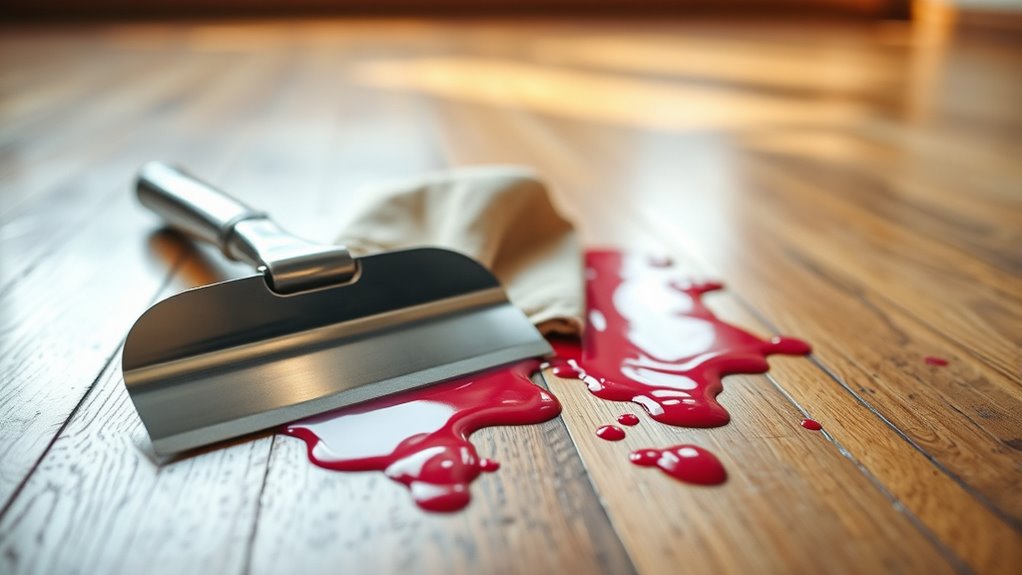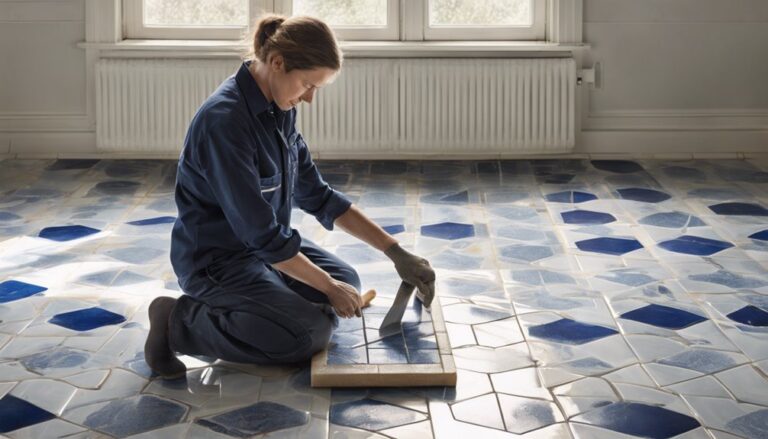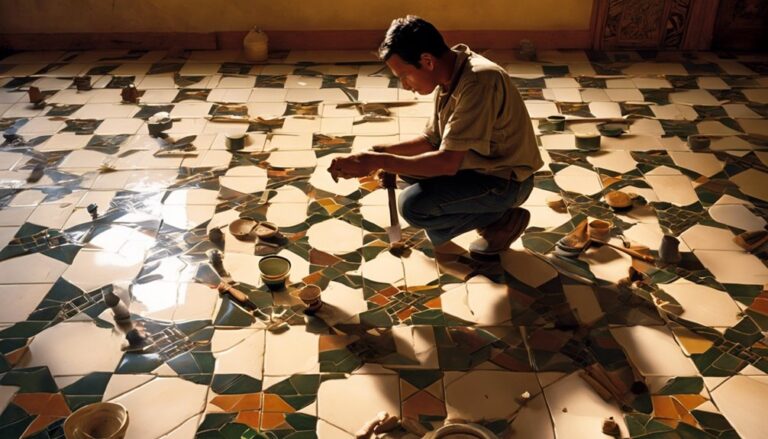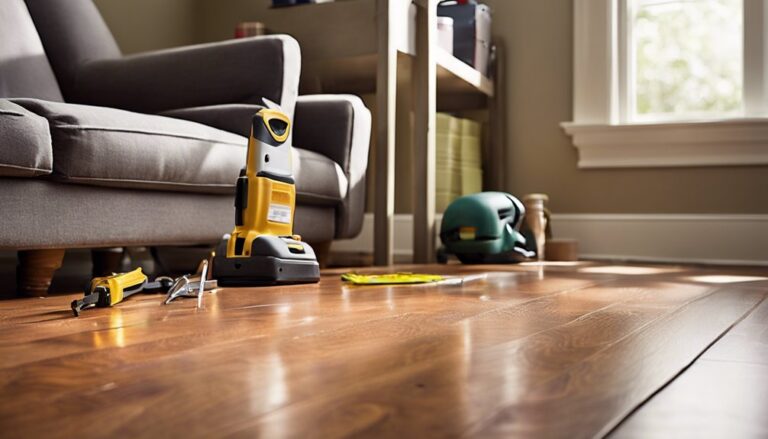To get dry paint off your hardwood floors, first identify if the paint is water- or oil-based, as this guides your approach. Start by gently softening the paint with rubbing alcohol or warm soapy water, applied with a soft cloth. For tougher spots, carefully use acetone on a cloth, testing a hidden area first to avoid damage. Fine steel wool can help remove stubborn paint, applied lightly with care to protect the wood. Learn more about safe techniques and restoring your floor’s finish after removal.
Assessing the Type of Paint on Your Hardwood Floors
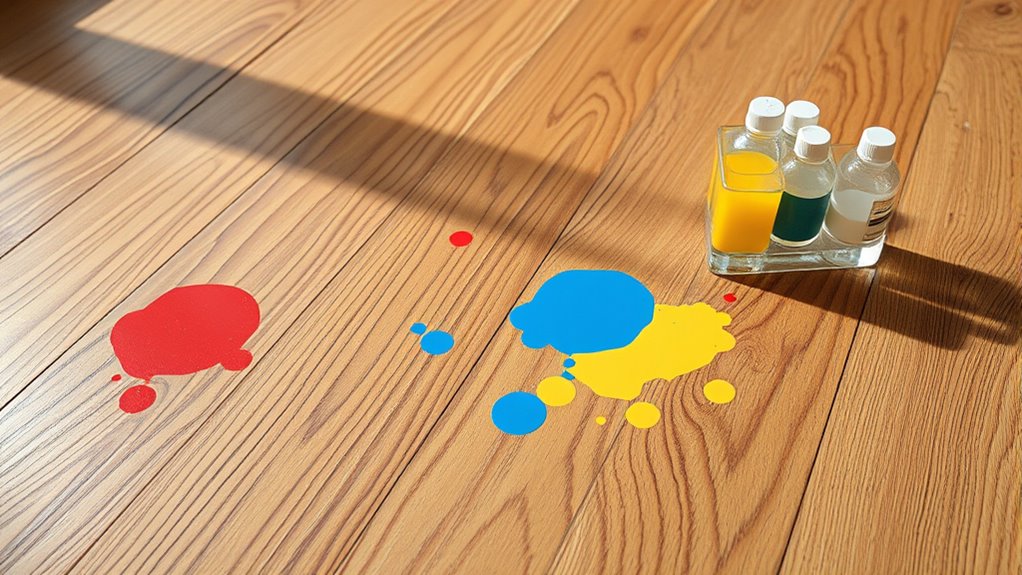
Before you start removing dry paint from your hardwood floors, you need to identify what type of paint you’re dealing with. Paints generally fall into two categories: water based paints and oil based paints. Water based paints, often latex or acrylic, are easier to clean and tend to soak into the wood less aggressively. Oil based paints, on the other hand, are tougher, more durable, and adhere strongly to surfaces, making removal more challenging. To determine the type, check the paint can if available or test a small spot with rubbing alcohol—water based paints will soften, while oil based paints won’t. Knowing this distinction is essential because it dictates the removal method and materials you’ll need, allowing you to regain control of your space without causing damage to your hardwood floors.
Gathering the Right Tools and Materials
Once you know whether the paint is water based or oil based, you can gather the appropriate tools and materials for removal. Proper tool selection guarantees you work efficiently without damaging your hardwood floors. Different material types are suited to each paint category, so get them ready before you begin.
| Tool/Material | Purpose |
|---|---|
| Plastic scraper | Gentle removal of dried paint |
| Soft cloths | Wiping and cleaning residues |
| Warm soapy water | For water-based paint softening |
| Mineral spirits | For oil-based paint breakdown |
| Fine steel wool | Removing stubborn paint spots |
Having these tools and materials on hand gives you freedom to tackle paint removal methodically and precisely.
Preparing the Floor for Paint Removal
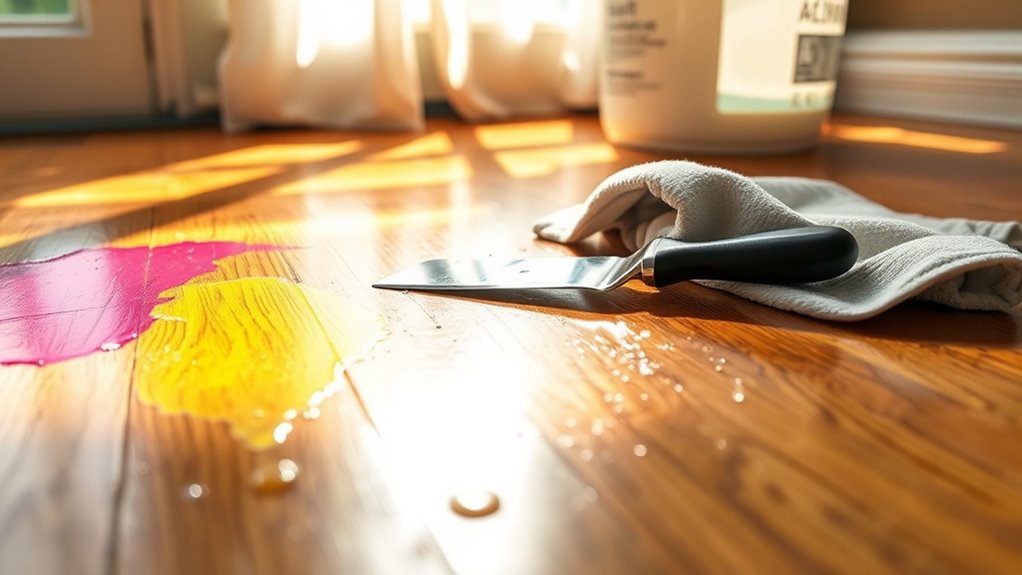
Before you start removing paint, make certain to clear the floor area completely to avoid any obstacles. Test your chosen paint removal method on a small, hidden section to verify it won’t damage the hardwood. Finally, gather protective supplies like gloves and drop cloths to keep yourself and the surrounding area safe.
Clear the Floor Area
Although it may seem simple, clearing the floor area is a crucial first step to effectively remove dry paint from hardwood floors. Start by removing all furniture, rugs, and objects to create an open workspace. This organization guarantees you won’t accidentally damage belongings or trip during the process. Next, inspect the floor for any loose debris or dust and sweep thoroughly to maintain floor safety. Clear, unobstructed space lets you maneuver tools freely and observe paint spots clearly. If needed, use painter’s tape along baseboards to protect adjacent surfaces. By preparing your workspace with care, you reduce risks and set yourself up for efficient paint removal. Taking these steps methodically gives you the freedom to work confidently, minimizing distractions and hazards.
Test Paint Removal Methods
Testing paint removal methods is essential to protect your hardwood floors from damage. Before tackling the entire area, evaluate how well different techniques work on small, inconspicuous spots. This helps you understand paint adhesion and removal effectiveness. Follow these steps:
- Choose a hidden corner or an edge near the baseboard.
- Apply a small amount of your selected paint remover or solvent.
- Let it sit for the recommended time, then gently rub with a soft cloth.
- Observe any changes to the paint and the wood finish, noting if the paint lifts easily without harming the floor.
Gather Protective Supplies
To protect your hardwood floors during paint removal, you’ll need to gather the right supplies that prevent damage and contain messes. Start by putting on protective gloves to shield your skin from harsh chemicals or scrapers. Safety goggles are essential to guard your eyes from splashes or debris. Lay down a drop cloth or plastic sheeting around the affected area to catch paint chips and spills. Use painter’s tape to secure the covering and protect adjacent baseboards or walls. Keep a bucket of warm water and clean rags nearby for immediate cleanup of any spills. Having these protective supplies organized before you begin guarantees a controlled, safe environment, allowing you to work efficiently without risking harm to yourself or your hardwood floors.
Using Warm Soapy Water for Fresh Paint Spots
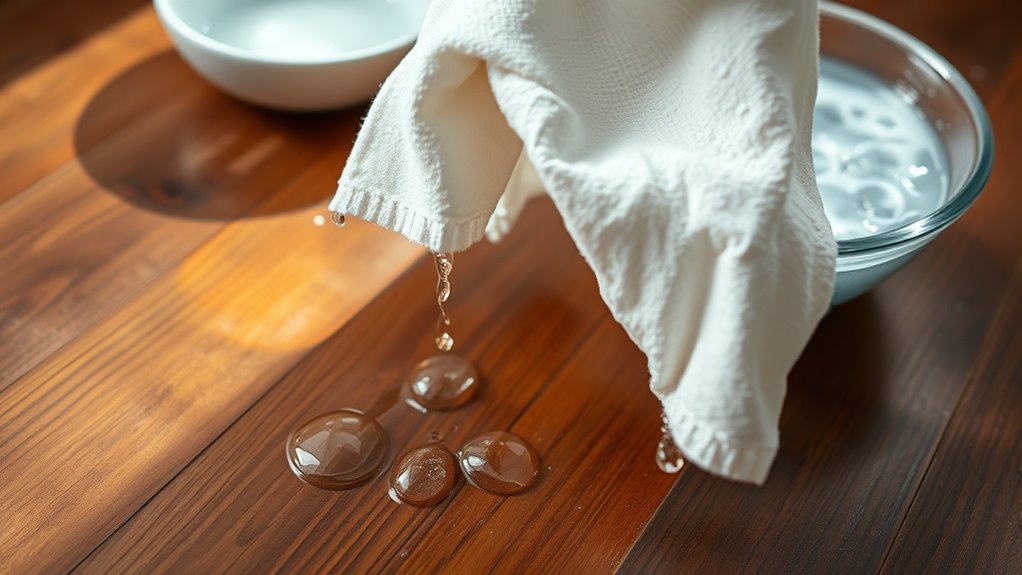
Start by mixing warm water with a few drops of mild dish soap to create a gentle cleaning solution. This soap mixture effectively loosens fresh paint without damaging your hardwood floors. Follow these steps carefully:
- Dip a soft cloth or sponge into the warm water and soap mixture.
- Gently blot the fresh paint spot—avoid scrubbing to prevent spreading.
- Let the solution sit on the paint for a minute to soften it.
- Wipe away the paint with a clean, damp cloth, repeating as necessary.
This method relies on patience and gentle action, giving you control and freedom to restore your floors without harsh chemicals. Remember, acting quickly while the paint is fresh guarantees the best results with this simple soap mixture.
Applying Rubbing Alcohol to Loosen Dried Paint
When warm soapy water isn’t enough to remove dried paint from your hardwood floors, rubbing alcohol can be an effective next step. Start by pouring a small amount of rubbing alcohol onto a clean cloth or cotton ball. Gently dab the dried paint spot, allowing the alcohol to soak in and soften the paint. Avoid saturating the wood, as excessive moisture can damage the floor. After a few minutes, use the cloth to rub the paint gently, loosening it without scrubbing aggressively. Rubbing alcohol works by breaking down the paint’s adhesion, making paint removal easier. Repeat this process as needed, always testing a hidden area first to verify the finish remains intact. This method provides a controlled, safe way to tackle stubborn dried paint without compromising your hardwood floors.
Employing a Plastic Scraper to Avoid Floor Damage
You’ll want to select a plastic scraper with a thin, flexible edge to prevent scratching your hardwood floors. Use gentle, controlled strokes at a low angle, gradually lifting the paint without forcing the tool. This method minimizes damage while effectively removing dried paint.
Choosing the Right Scraper
Although metal scrapers might seem more effective, opting for a plastic scraper is essential to prevent scratching your hardwood floors. When selecting the right scraper, understanding scraper materials and scraper types helps you avoid unnecessary damage.
Consider these points:
- Material: Choose plastic over metal to protect the wood finish.
- Blade Flexibility: Softer, flexible blades conform better to floor contours.
- Handle Design: Ergonomic handles provide better control and reduce hand fatigue.
- Blade Size: Smaller blades allow precise removal in tight spots without harming surrounding areas.
Techniques for Gentle Removal
Two key techniques guarantee you remove dry paint gently without damaging your hardwood floors: applying steady, controlled pressure and working in small sections. Start by holding a plastic scraper at a low angle to the floor, carefully sliding it beneath the paint. Avoid forcing the scraper, as this can gouge the wood. Instead, use gentle techniques, letting the tool do the work. Focus on small patches, gradually lifting the paint without rushing. If paint resists, soften it with a damp cloth before scraping again. This methodical approach assures effective paint removal while preserving your floor’s finish. Patience and precision give you the freedom to restore your hardwood floors safely, combining control with care for the best results.
Utilizing Acetone or Nail Polish Remover Safely
One effective method to remove dry paint from hardwood floors involves using acetone or nail polish remover, but it’s essential to handle these solvents with care. Prioritize acetone safety to protect your floors and yourself. Follow these steps:
- Test a small, hidden area first to check for finish damage.
- Use a soft cloth lightly moistened with nail polish remover; avoid soaking the wood.
- Work in a well-ventilated area and wear gloves to minimize skin contact.
- Gently rub the paint spot, stopping immediately if the wood’s finish starts to dissolve.
Trying Commercial Paint Removers Designed for Hardwood
If acetone or nail polish remover doesn’t fully lift the paint or concerns about damaging your hardwood finish arise, commercial paint removers made specifically for hardwood floors can offer a safer alternative. These commercial products are formulated to break down paint without harsh chemicals that strip or dull your wood. Before applying, test the remover on a hidden spot to verify it won’t harm the finish. Use a soft cloth or sponge to apply the product gently, following manufacturer instructions closely. Allow enough time for the remover to work, then carefully wipe away softened paint. Repeat the process if needed, always avoiding aggressive scrubbing. By using these targeted commercial products, you maintain control over paint removal while protecting your hardwood’s integrity and preserving your freedom to restore your floors safely.
Addressing Stubborn Paint With Fine Steel Wool
When softer methods don’t fully remove dried paint, fine steel wool can be an effective next step for addressing stubborn spots. Using steel wool techniques properly helps you avoid damaging your hardwood while tackling stubborn paint removal.
Fine steel wool offers a gentle yet effective solution for removing stubborn dried paint without harming hardwood surfaces.
Follow these steps:
- Choose the finest grade steel wool (#0000) to minimize scratching.
- Lightly dampen the steel wool with soapy water or a gentle solvent.
- Gently rub the paint spots in the direction of the wood grain, applying minimal pressure.
- Wipe away loosened paint residue frequently to monitor progress and prevent buildup.
Restoring and Refinishing the Hardwood After Paint Removal
Although you’ve removed the paint, your hardwood floor may still show signs of damage or dullness. To restore its original beauty, start by evaluating the affected areas for scratches or discoloration. Employ repair techniques such as light sanding to smooth imperfections without compromising the wood’s integrity. Use fine-grit sandpaper and work in the direction of the grain to avoid further damage. Once the surface is even, clean the dust thoroughly. Next, consider finishing options that match your floor’s existing sheen—whether it’s matte, satin, or gloss. Apply a compatible polyurethane or oil-based finish evenly, allowing proper drying time between coats. These steps will revive your hardwood floor’s appearance, ensuring it looks natural and well-maintained while giving you the freedom to enjoy your space without worry.

